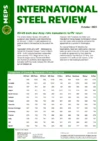US steel demand supported by construction’s resilience
The United States construction sector continues to drive steel demand despite the challenges posed by an evolving supply chain and increased costs resulting from elevated interest rates.
Growth is particularly strong in a manufacturing construction segment driven by federal programmes and reshoring efforts to return manufacturing and services to the US from overseas. This sustained momentum (depicted within the graph above) is expected to support the US steel markets in 2024.
- MEPS International delivers monthly price data and commentary from the US steel market in its International Steel Review publication. Contact MEPS for details of the report and how to subscribe.
Construction is the primary steel-consuming sector, accounting for over 50% of consumption, according to the 2023 worldsteel report. Typically, interest rates have a significant impact on steel demand because the construction and automotive sectors often rely on financing through loans. The Federal Reserve has maintained interest rates above 5% throughout the past year, raising concerns among steel producers about a potential economic slowdown.
Despite this, there are strong indicators that government policies designed to boost the construction sector are working.
Construction spending rose by 10.9% year-on-year in April, data published by the US Census Bureau showed. This strong increase was led by manufacturing (17.3%), highway/street (16.4%), and educational (16.2%) construction. Lodging and commercial construction continue to be a drag on the sector, however.
Manufacturing investment leading the charge
Manufacturing construction has exploded since the implementation of several federal programmes, including the CHIPS Act and the Inflation Reduction Act (IRA), in August 2022. The CHIPS Act provides investment incentives for the research and manufacturing of semiconductors in the US, while the IRA provides investment incentives for solar, wind, and other clean energy provisions over the next 10 years. Since their introduction, monthly spending on manufacturing construction has more than doubled to over USD200 billion and now represents the largest category of nonresidential construction in the US.
Reshoring efforts have also boosted manufacturing investment. Tariffs, the Buy American requirement in the Infrastructure Investment and Jobs Act, rising geopolitical tensions, and pandemic supply chain challenges have forced US-based companies to reconsider their import decisions.
The following major manufacturing construction projects have been announced, or are currently in construction, across the US:
- Intel is developing four new chip plants in Arizona and Ohio as well as implementing upgrades to its existing facility in Arizona. Its total investment is estimated at USD100 billion.
- Micron will spend over USD40 billion on new semiconductor facilities in New York and Idaho.
- Samsung is building a new USD25 billion semiconductor plant in Texas.
- LG Energy Solutions is investing in new battery production facilities in Arizona and Georgia.
The South Atlantic region is benefiting the most from the manufacturing investment. According to experimental data from the US Census Bureau, private manufacturing construction in the South Atlantic region (Florida, Georgia, South Carolina, North Carolina, Virginia, West Virginia, Maryland and Delaware) grew 71% year-on-year in April and has more than doubled since August 2022 – the strongest growth of any US region.
Key indicators still mostly positive
Despite the continued positive momentum for US construction, the leading indicators are currently mixed. The Dodge Momentum Index, which reports on projects in the planning stage, rose by 6.1% in April, led by a robust showing for data centers. The Associated Builders and Contractors reported a healthy backlog of 8.4 months for April, although this was down from its recent peak of 9.3 months in July 2023. Meanwhile the architectural billing index (ABI), an established leading indicator for nonresidential construction published with the American Institute of Architects, registered its ninth consecutive month under 50 in April, signaling contraction. However, the ABI did jump to 48.2 from a low 43.6 in March.
The US economy has so far avoided the recession that everyone feared as the Fed made successive interest rate rises. Most economists forecast a 2024 GDP growth rate of between 2% and 2.5%. Meanwhile, the headline S&P Global Flash US PMI Composite Output Index rose sharply to 54.4 and the flash manufacturing PMI by S&P Global rose above 50 in May, supporting continued positive momentum.
While some leading indicators present a mixed picture, the overall momentum in the construction sector remains positive, particularly in manufacturing construction. The healthy backlog reported by builders and the upward trends in key economic indices support a positive outlook for the US economy and the steel sector in 2024.

Source:
International Steel Review
The MEPS International Steel Review is an essential monthly publication, offering professional analysis and insight into carbon steel prices around the world.
Go to productRequest a free publication






